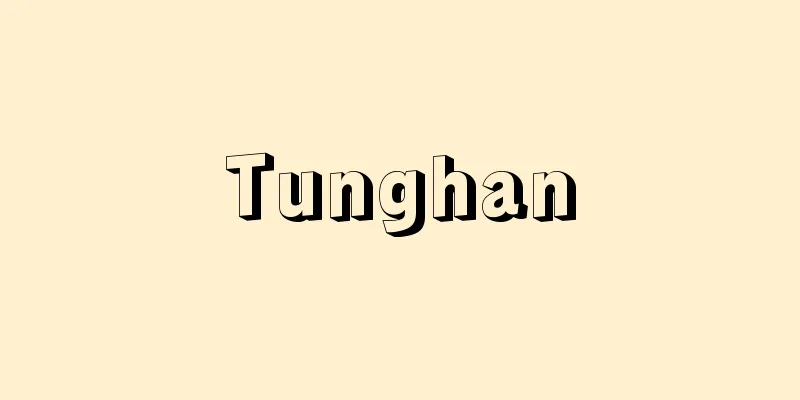Cyan

|
[ I ] Cyanogen: (CN) 2 (52.03). Also called dicyan. It is produced by adding a concentrated aqueous solution of potassium cyanide or sodium cyanide to a concentrated aqueous solution of copper(II) chloride or copper(II) sulfate. At -90°C, it forms an orthorhombic crystal with a linear molecule of N≡CC≡N. NC is approximately 1.15 Å, CC is approximately 1.38 Å. At room temperature, it is a highly toxic colorless gas. It has a faint almond odor. Melting point -27.9°C, boiling point -21.2°C. Easily soluble in water, alcohols, and ether. In aqueous solution, it hydrolyzes to hydrogen cyanide (HCN) and cyanic acid (HOCN). In an alkaline aqueous solution, it becomes an alkali cyanide. These properties are similar to those of halogens (e.g. Cl2 ), so it is also called a halogenoid. If the aqueous solution is left at room temperature for a long time, various substances such as oxalic acid, ammonia, and urea will be produced. When burned, it burns with a pink flame and reaches a high temperature of 4600 K, so it is used in flame photometry (flame spectrometry). When heated for a long time at 300 °C, it becomes a brown solid polymer called paracyanogen. When heated further, paracyanogen begins to decompose again at about 800 °C to produce (CN) 2 , and at about 1000 °C it begins to produce the free radical CN, and at temperatures above about 1500 °C it decomposes into C and N. Paracyanogen can be thought of as a chain-like polymer as shown in the figure. Cyanide is used as a raw material in organic synthesis and in the synthesis of thiocyanato compounds, as well as as an insecticide. [CAS 460-19-5] [ II ] Cyan: A blue-green color. For example, in color photography, it is the complementary color of red among the three primary colors of red, blue, and green in positive films, and in negative films, the parts that correspond to the red color of the positive are colored with this color. Its absorption center is around 650 nm. Source: Morikita Publishing "Chemical Dictionary (2nd Edition)" Information about the Chemical Dictionary 2nd Edition |
|
【Ⅰ】シアン(cyanogen):(CN)2(52.03).ジシアン(dicyan)ともいう.塩化銅(Ⅱ)または硫酸銅(Ⅱ)の濃水溶液に,シアン化カリウムまたはシアン化ナトリウムの濃水溶液を加えると生成する.-90 ℃ では斜方晶系結晶で,N≡C-C≡Nの直線形分子.N-C約1.15 Å,C-C約1.38 Å.室温では猛毒の無色の気体.淡いアーモンド臭がある.融点-27.9 ℃,沸点-21.2 ℃.水に易溶,アルコール類,エーテルに可溶.水溶液は加水分解して,シアン化水素HCNとシアン酸HOCNになる.また,アルカリ水溶液ではシアン化アルカリになる.これらの性質はハロゲン(たとえば Cl2)に似ているので,ハロゲノイドともいわれる.水溶液を室温で長く放置すると,シュウ酸,アンモニア,尿素など種々のものを生成する.燃焼させるとピンク色の炎をあげて燃え,4600 K の高温に達するので炎光分析(フレームスペクトル)に用いられる.300 ℃ で長く加熱すると,褐色固体のポリマーのパラシアン(paracyanogen)になる.さらに加熱すると,パラシアンは約800 ℃ で再分解をはじめて (CN)2 を生じ,さらに約1000 ℃ で遊離基CNを生じはじめ,約1500 ℃ 以上になるとCとNとに分解する.パラシアンは図のような鎖状のポリマーと考えられる. シアンは,有機合成やチオシアナト化合物合成の原料となるほか,殺虫剤として用いられる.[CAS 460-19-5]【Ⅱ】シアン(cyan):青緑色系の色.たとえば,カラー写真などでポジの赤,青,緑の三原色中,赤の補色で,ネガではポジの赤色に対応した部分をこの色で着色する.吸収の中心は約650 nm. 出典 森北出版「化学辞典(第2版)」化学辞典 第2版について 情報 |
Recommend
Wesendonck Songs - Wesendonck Songs
…Upon learning of this, he fled Dresden and went ...
rajas
…The material principle is composed of three elem...
Nobutsura Hasebe - Nobutsura Hasebe
Year of death: Kenpo 6.10.27 (1218.11.16) Year of ...
cura
...It is played with a cherry bark or plastic ple...
First-order phase transition
Phase transitions such as the melting of a solid o...
Ulug-Khem (English spelling)
…Coal reserves in Siberia provide fuel for most o...
History of Impressionist Painters - History of Impressionist Paintings
…He began writing Salon (official exhibition) rev...
Okashima
(Also "Okajima") One of the surnames. So...
Pépin l'Ancien (English spelling)
…He was the founder of the Carolingian dynasty. H...
Joraisi - Joraisi
A writer of Kanazoushi (Japanese traditional writ...
Legal act - Houritsu koui
A legal act is an act that a person performs with...
space transportation system
…Spacelab is a nickname that is an abbreviation o...
Privateer - Shiryakusen
Also known as a chartered privateer. An armed ship...
Clair Omar Musser
...It spread from Africa to Central America, and ...
Hinenosho
This was a manor owned by the Kujo family in Hine...









